Conguillio and the monkey puzzles

Caramor - sailing around the world
Franco Ferrero / Kath Mcnulty
Wed 22 Feb 2017 17:34
38:38.27S 71:42.04W A Road Journey through Central Chile Although Franco and I have travelled the best part of 6,000km through Chile, we had yet to see a monkey puzzle tree in the wild. We turned off Ruta 5, refuelled in Curacautín and headed east. The lush fields of wheat and barley dotted with roble (Nothofagus obliqua) gave way to an arid landscape of black lava flows and the pointy cone of Volcán Llaima. Ahead, in the distance we could see trees, different to any we had seen before, more spiky, nearly alien; we had arrived in the land of the monkey puzzles. 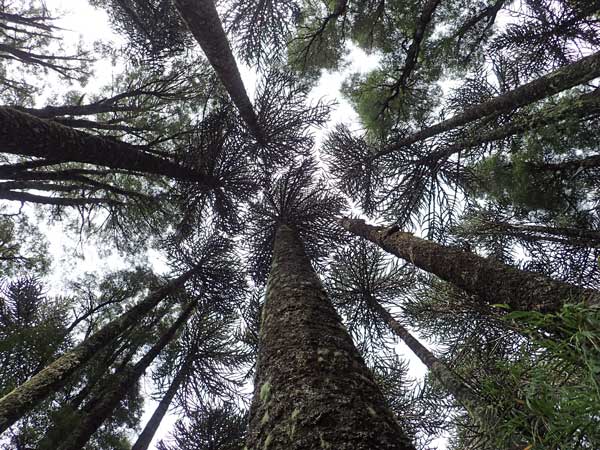 Monkey puzzle canopy Araucaria araucana, although a fairly common tree in the UK (I even had one growing at Tan-y-Coed until it succumbed to a freak strimming accident), is marked as ‘Endangered’ on the IUCN red list. Its native habitat is restricted to a tiny zone about half the size of Anglesey above 800m in the Chilean-Argentinian Andes between latitudes 37˚ and 39˚. Two degrees of latitude is the distance between north and south Wales! To thrive, it needs volcanic soils, snow cover and cold temperatures. It grows very slowly, living for over a thousand years and can reach heights of 50m and a girth of 2-3m in diameter. It is usually in mixtures with coigüe (Nothofagus dombeyi) and lenga (Nothofagus pumilio) but can also exist in pure stands. The monkey puzzle fruit, the piñon (pine nut), used to be a very important source of protein for the Mapuche who roamed the Andean foothills. They also used the sap to cure skin diseases. Unfortunately, the early colonists burned large swathes of forest to clear land for agriculture. Trees were also cut down to be used for construction and in more recent times forests have been harvested for pulp, highly sought after by the high grade paper industry. Today the trade in monkey puzzle timber is illegal and all the remaining stands are protected in national parks. Despite these measures, it will take a very long time for forests to recover. 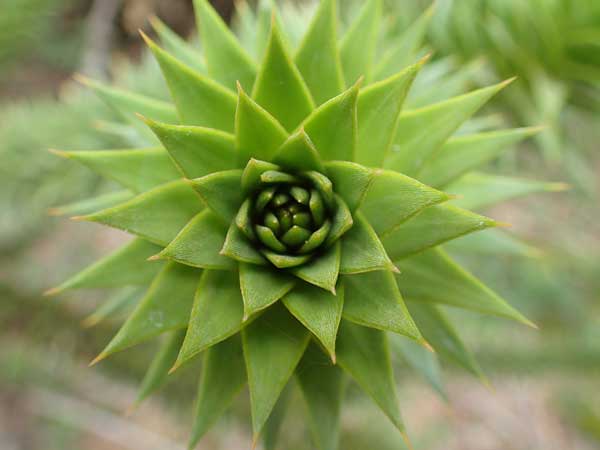 Monkey puzzle shoot tip 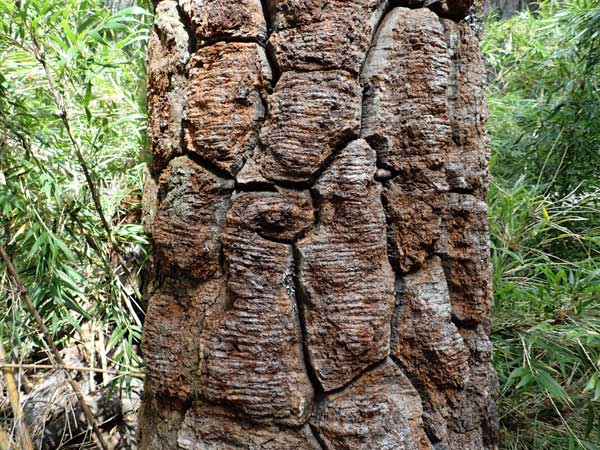 Monkey puzzle bark We arrived at the Conguillio National Park gate just before closing time and paid our dues. “By the way” remarked the park warden, “there is no camping by Lago Captrén and the first campsite at Lago Conguillio is full so you will need to drive a further 17km to reach the second campsite”. This was bad news indeed, the track was rough and according to my guidebook, we could camp at Lago (lake) Captrén, clearly no longer the case. A little further on, the single track headed steeply uphill and as we got half way up, a long queue of cars appeared at the top, on their way down. Reversing all the way back down to Lago Captrén, on the badly rutted road wasn’t easy and when the other drivers told us the route was as awful all the way, we decided to give up. The US$800 excess on the hire car was a potent dampener to enthusiastic driving. Peace and tranquility returned with the departure of the last day tourists. We watched the light change over the small lake as the sun set behind the hills. The beach was just large enough for three tents. Applying Franco’s principle that it is ‘easier to obtain forgiveness than to ask for permission’, we settled down for the night. 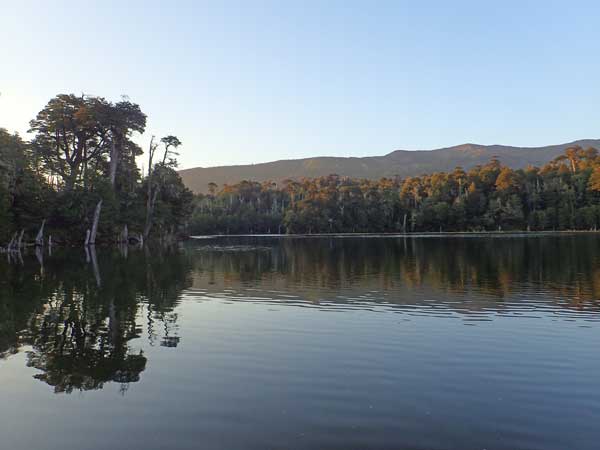 Lago Captrén In the morning Julie found a tarantula cuddling up to her in the tent. Bravely she didn’t let the incident put her off breakfast. As we were clearing up, the park rangers arrived and gave us a ticking off. We looked sufficiently chastised. The weather was changing, fog had descended during the night and we hoped it would help extinguish the fires that were still blazing further north. All our gear back in the car, we set off on the ‘Carpintero (woodpecker) Trail’. 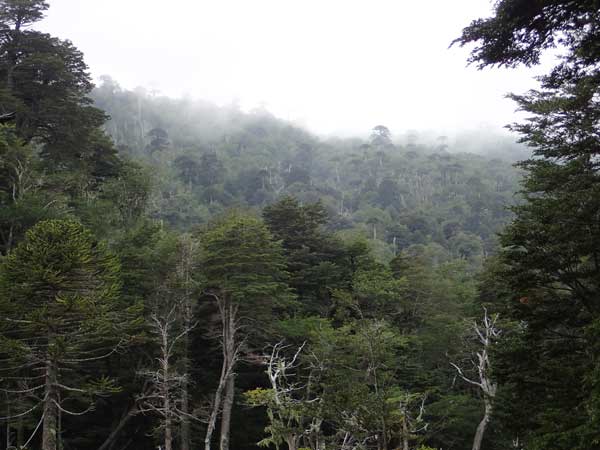 Monkey puzzles in the mist 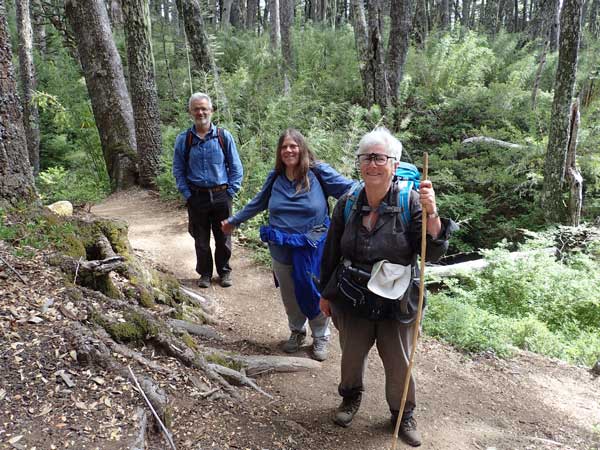 Franco, Julie and Angie on the Carpintero Trail The path descended past several very large trees, one of which is reckoned to be a thousand years old 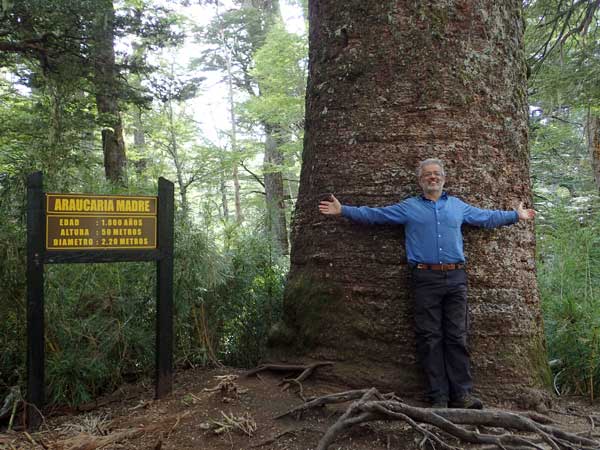 The mother Araucaria with Franco for scale The path ended at the excellent visitor centre and we stopped for lunch. Franco found a small cut on the sole of his foot which was causing him considerable discomfort. He used this as an excuse to head back alone. Angie, Julie and I stayed a little longer in the visitor centre and then set off back along the path. We didn’t have far to go when it started to rain, yet it was long enough for us to be absolutely soaking despite our waterproof coats. Franco, cunningly, had made it back in time! (He is somewhat allergic to getting rained on and maybe the foot cut is the latest symptom of this ailment). Since we couldn’t really camp another night at Lago Captrén (not that any of us fancied putting up the tent in the deluge), we had to leave. 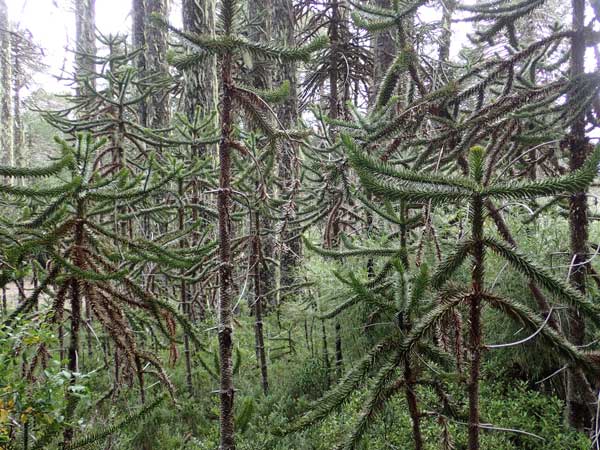 Pure stand of young monkey puzzle trees We drove back to Curacautín, trying to warm up and demist the windows and still it lashed down. In the main street, we held a hasty powwow and decided to book into a hostel. I could have sworn that a few days earlier there had been signs for hostels everywhere. In despair I walked into a run down looking restaurant. The family stopped eating and stared at me “You ain’t from ‘round these parts, are y’all?”. They pointed me down the road where I found Hostal Araucandina run by a vet and a lawyer. This nice couple didn’t mind me dripping water everywhere. They showed me their plush room and living area. We could all fit into it, it would be like camping, and cheap. I returned to the car, excited by my success. “Share a room?” my companions moaned. We tried a few other places but they were all shut. Back in the tastefully decorated lounge, the vet was explaining the different keys he had given us. Distracted by the sound of chewing, he looked up, Franco and Julie were munching their way through the home décor, a bowl of monkey puzzle nuts. “You can’t eat those raw” he exclaimed, incredulous, “they have to be boiled for hours, those are just for show.” 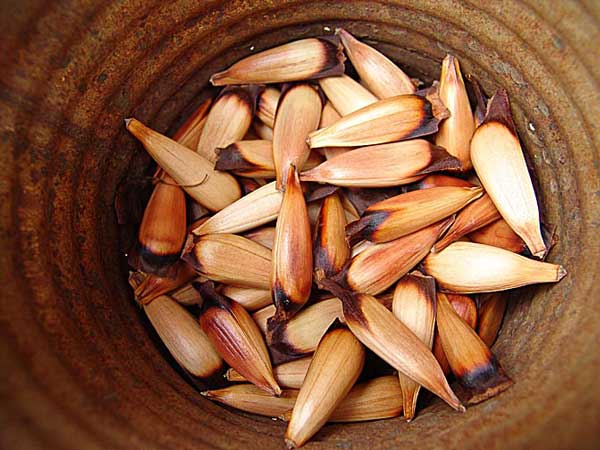 Home décor - pine nuts in a bowl Meanwhile Angie had occupied the kitchen and was washing her filthy clothes in the sink. Our host kindly lit the fire in the large hearth occupying one end of the room. Before leaving he replaced the fire screen to prevent sparks flying into the room. A while later, his wife, the lawyer, came through to make sure we had everything we needed. She was horrified to find Angie’s clothing drying on the fire screen and became convinced we were trying to burn her house down. Her kitchen was lined with all our dirty dripping clothing. Then came the discussion of who would sleep where and Julie, a noisy sleeper, generously offered to sleep on the sofa in the living room. What our landlords made of finding a guest asleep on their sofa, we shall never know … Much to their relief, no doubt, we left early the next morning having demolished the delicious breakfast they had provided. |